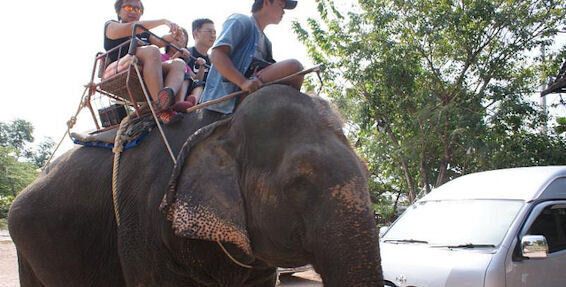Elephant trekking has appeared on many travellers' bucket list and has become a 'must-do' activity in recent years. However, in our pursuit for adventure are we unwittingly fuelling an ongoing demand for more elephants to be illegally captured from the wild, with dire consequences? With no more than 45,000 Asian elephants left in the wild, are there better ways that we as tourists, could appreciate and help conserve these incredible animals?

Elephant trek. Credit: David Bailey
This week, our new online guide: Elephants in tourism - right or wrong? - (http://www.responsibletravel.com/holidays/elephant-conservation/travel-guide) launches on responsibletravel.com, aiming to present travellers with a 'behind the scenes' insight into the world of elephants involved in tourism. Having consulted with tourism ventures across Asia and Africa as well as elephant-related charities, it tackles all sides of the debate and there is good reason why opinions run high on this.
How elephants became a tourism commodity
Elephants have been used as beasts of burden across India and Southeast Asia for many hundreds of years and more recently by the logging industry to remove timber from the forests. Their incredible intelligence means they can be taught to obey complex commands and build strong relationships with their owners.
After commercial logging was banned in Thailand in 1989, unemployed 'mahouts' or elephant handlers began to use their animals to give paid-for rides to tourists. Many elephants ended up in camps where they were trained to display their old logging skills in shows, to dance to music and to paint. Others went to sanctuaries alongside elephants who may have been injured or orphaned in the wild or made to 'beg' on the streets to get money from tourists. Sadly, there are no laws or regulations regarding the welfare of captive elephants across Asia and consequently many establishments exploit the animals to attract the tourist dollar.
Elephant evil
One of the chief problems with captive elephants in tourism is the demand it fuels for wildlife trafficking. Wild adults are often gunned down so that the baby elephant can be captured and then sold into tourist camps. After being captured, the calves are likely to be subjected to the horrific practice of 'crushing' or 'breaking' an elephant's spirit, which involves keeping the young elephant tied up in a cage for several days. It may be deprived of food, water or sleep, and beaten, burned and stabbed to literally beat it into submission. A newly broken in baby elephant can be worth thousands of pounds. Further physical abuse and punishment is used to train the animal to perform or ride with people on their back or necks.
There is also plenty of evidence to show that the act of riding an elephant itself is cruel, and can cause damage to the spine and stunt growth. The lack of welfare standards for sanctuaries and camps means they can be ridden all day, chained all day, carry as many tourists as will fit on their backs, and hit with bull hooks to control them. In extreme cases, they may also be given amphetamines to suppress their huge appetites and make them work longer hours.
Another side?
For some though, the age-old tradition of elephant handling is a precious way of life to many communities, passed through the generations and should not be toiled with. It is for this reason that I believe a gradual change is needed, to allow time and adequate support for communities to adapt.
Additionally, defenders of elephant riding may compare it to horse riding. The key misunderstanding is that elephants are not, in fact, "domesticated" - they are captive, wild elephants. Due to the difficulty of breeding elephants in captivity, they have never undergone controlled breeding in the same way as other domesticated animals; all their wild instincts remain even if they have been born in captivity or captured as babies.
How to be an elephant-friendly traveller
-If you are considering an encounter with African or Asia elephant as part of a future holiday, research carefully before choosing an elephant camp or sanctuary to visit. Look at the websites along with review sites to see what other travellers have to say and avoid those that offer performances and rides, and that keep their elephants in chains.
-Responsibletravel.com's (http://www.responsibletravel.com/holidays/elephant-conservation) elephant holidays have already been screened and do not support sanctuaries or camps that offer performances or rides.
-Asking questions can help, as Dave Tucker from The Beyond Tourism Co explains: "I keep hearing stories of Thai-run elephant camps that are changing to be 'no rides' within Thailand because of what customers were saying to them. So my advice to tourists is: if the camp is doing shows or rides, avoid it. Even better, write them an email and tell them why you are avoiding it so that it's very clear and unambiguous and puts more pressure on them to change things."
-Consider viewing these animals in the wild instead. Nothing beats seeing a truly wild elephant strutting across the African savannah or shuffling through an Asian forest. You will learn far more in just a few minutes with a wild herd than you would from days with a captive individual.
With a little thought and a questioning mind we can still enjoy these wonderful creatures; creating travel memories that will last forever and helping to conserve this precious endangered species for many generations to come.
See http://www.responsibletravel.com/holidays/elephant-conservation/travel-guide for more information as well as the best places to see elephants in the wild.